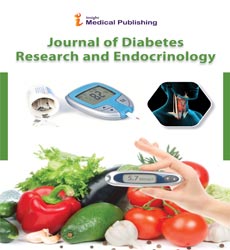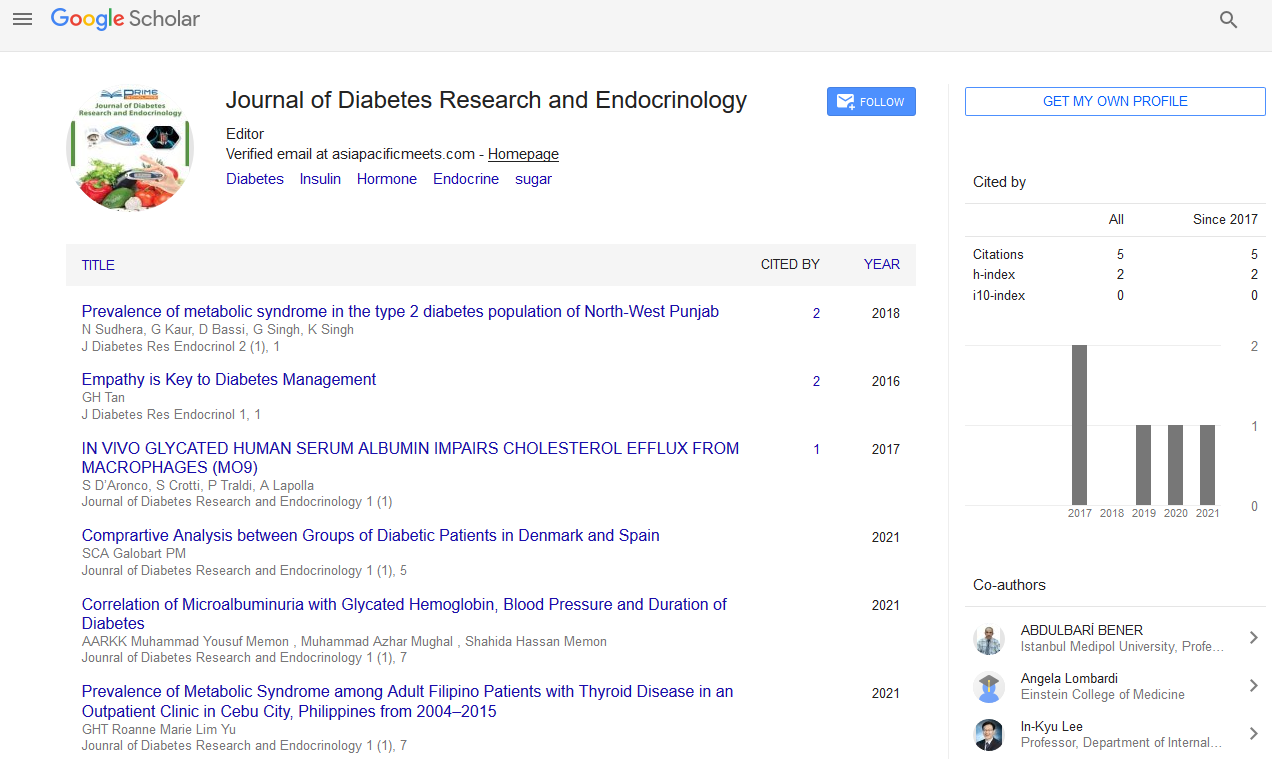Maheswari Neelapu*
Department of Endocrinology, Sawai Man Singh Medical College, Jaipur, India
- *Corresponding Author:
- Maheswari Neelapu
Department of Endocrinology
Sawai Man Singh Medical College
Jaipur, India
E-mail: dr.maheswari@gmail.com
Received Date: September 21, 2021; Accepted Date: October 05, 2021; Published Date: October 12, 2021
Citation: Neelapu M (2021) A Brief Note on Consequences and Types of Diabetes Mellitus. J Diabetes Res Endocrinol Vol.5 No.S1:002.
Description
Diabetes Mellitus (DM) is a chronic disorder characterized by fasting and/or postprandial hyperglycemia with plasma glucose levels that are above defined limits during oral glucose tolerance testing or random blood glucose measurements as defined by established criteria.
Type 1 Diabetes
There is absolute insulin deficiency due to autoimmune destruction of beta cells. There is also a genetic susceptibility to the disease. The main genetic abnormality is in the major histocompatibility complex on chromosome 6. This usually presents at a younger age.
Type 2 Diabetes
This occurs due to insulin resistance or insensitivity of tissues to insulin and relative insulin deficiency (and may later lead to absolute insulin deficiency). Obesity is a major risk factor for the disease. The insulin resistance seems to be caused by the toxic effects of increased lipid accumulation which interferes with insulin signalling processes between receptor activation and cellular effects some studies have shown that obese individuals have less number of insulin receptors in muscle, adipose tissue and liver. They usually show an improvement in glucose tolerance with exercise.
Consequences of disturbed carbohydrate metabolism
Decreased entry of glucose into insulin-sensitive cells and also increased release of glucose from the liver leads to hyperglycemia. Glucose is a major source of energy in the cell and due to deficient intracellular glucose protein and fat resents are used for energy. The increased breakdown of fat leads to ketosis. Poly urea, polydipsia and polyphagia arc seat in some diabetic patients. The renal threshold for glucose is 180 mg%. i.e. if the plasma glucose value is raised above ISO mg%. The ability of the kidney to reabsorb glucose is exceeded and glucose will start appearing in urine (Glycosuria). Thus, as glucose is lost in the urine. Water is osmotically dragged along with it (osmotic diuresis) leading to an increased wine output (polyuria). Since lot of water is lost in the urine. it leads to dehydration and this triggers the processes regulating water intake and causes increased thirst (Polydypsia) Electrolytes arc also lost in the urine. The quantity of glucose lost in urine is enormous and thus to maintain energy balance the patient takes in large quantities of food. Reduced glucose utilization in the ventromedial nucleus of hypothalamus (satiety center) is also possibly the cause for the polyphagia The plasma glucose levels can get elevated to such an extent that the hyperosmolarity of plasma can cause coma called hyperosmolar coma.
Consequences of disturbed lipid metabolism
That is increased breakdown of lipids and decreased formation of fatty acids and triglycerides. A rise in fat level breakdown leads to increased formation of ketone bodies which leads to ketosis and acidosis. The ketone bodies include acetoacetate acetone and beta-hydroxybutyrate. The hydrogen tons formed from acetoacetate and beta-hydroxybutyrate are buffered to a great extent, beyond which metabolic acidosis occurs. The pH drops due to the acidosis and the increased hydrogen ion concentration stimulates the respiratory center causing the characteristic rapid and regular deep breathing called Kussamaul breathing. The acidosis and dehydration can lead to coma and even death. The hormone-sensitive lipase converts triglycerides to Free Fatty Acids (FFAs) and glycerol insulin has an inhibitory effect on this hormone. In the absence of insulin the FFA levels greatly increase. The FFA is catabolized to acetyl CoA in the liver and other tissues and the excess acetyl CoA is converted to form ketone bodies.
Consequences of disturbed protein metabolism
There is decreased protein synthesis and increased protein breakdown leading to protein catabolism and muscle wasting. There is increased plasma amino acids and nitrogen loss in urine. All this leads to negative nitrogen balance and protein depletion. Protein depletion causes poor resistance to infections. There is increased glucogenesis in the liver since the amino acids are convened to glucose.
Consequences of disturbed cholesterol metabolism
Diabetics are more prone for myocardial infarctions and stroke because the cholesterol levels are elevated causing atherosclerosis. This is due to an increase in LDL (Low-Density Lipoprotein) and VLDL (Very Low Density Lipoprotein) levels in the plasma, probably because of either augmented production of VLDL i.e. the liver or decreased removal of LDL and VLDL from the blood stream.
Further complications
Long standing uncontrolled diabetes can lead to
1. Microvascular complications like retinopathy, nephropathy and neuropathy involving the peripheral nerves and autonomic nervous system
2. Macrovascular complications like stroke, peripheral vascular disease and myocardial infarction due to increased atherosclerosis caused by increased amounts of LDL (as discussed above).
The microvascular complications are related to both duration of diabetes and uncontrolled plasma glucose levels. Increased intracellular glucose levels (in cells such as endothelial cells which are unable to down regulate glucose transport in the presence of increased extracellular glucose) cause formation of sorbitol due to activation of the enzyme aldose reductase. Sorbitol decreases sodium potassium ATPase activity. The increased intracellular glucose also nonenzymatically attaches to protein amino groups to form amadori products. The amadori products form Advanced Glycosylation End-Products (AGEs) which cause cross linkage of matrix proteins and it cause damage to blood vessels. There is also increased accumulation of sorbitol and fructose in Schwann cells due to hyperglycemia. This can interfere with its structure and function. Causes for delay in wound healing and gangrene in diabetes include
• Circulatory insufficiency due to atherosclerosis
• Neuropathy
• Protein depletion causes poor resistance to infections
• AGEs cause a decrease in leukocyte response to infections

